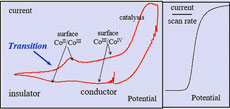Publication
891
ACS Appl. Mater. Interfaces, 11 (32), 28769-28773, 2019
DOI:10.1021/acsami.9b05240
|
|
|
|
|
|

|
Nature of Electronic Conduction in “Pseudocapacitive” Films: Transition from the Insulator State to Band-Conduction |
|
|
|
Cyrille Costentin, Thomas R. Porter, and Jean-Michel Savéant
Université Paris Diderot, Sorbonne Paris Cité, Laboratoire d'Electrochimie Moléculaire, Unité Mixte de Recherche Université – CNRS N° 7591, Bâtiment Lavoisier, 15 Rue Jean de Baïf, 75205, Paris Cedex 13, France
The transition between the insulator state and the band-conducting state is investigated by means of cyclic voltammetry in cobalt oxide porous film electrodes in phosphate-buffered solutions. It is shown that a proton-coupled faradaic oxidative process starting in the insulator region eventually builds an ohmic conduction mode upon anodic polarization. This model allows one to understand the origin of the authentic capacitive behavior of conductive metal oxide films rather than the so-called “pseudocapacitive” behavior. The particular example of cobalt oxide serves to illustrate the way in which, more generally, the behavior of “pseudocapacitors”, long ascribed to the superposition of faradaic reactions, is in fact that of true capacitors, once band-conduction has been established upon oxidation of the material. |

